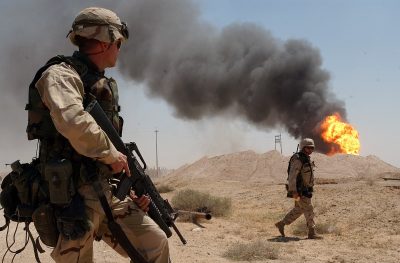Post-9/11 Era: One of the Most “Militarily Aggressive” Periods in US History
America has conducted nearly 400 interventions since its founding, with more than a quarter in the last 30 years.

All Global Research articles can be read in 51 languages by activating the “Translate Website” drop down menu on the top banner of our home page (Desktop version).
To receive Global Research’s Daily Newsletter (selected articles), click here.
Follow us on Instagram and Twitter and subscribe to our Telegram Channel. Feel free to repost and share widely Global Research articles.
***
The United States has conducted nearly 400 military interventions since 1776, according to innovative research by scholars Sidita Kushi and Monica Duffy Toft.
Half of those conflicts and other uses of force – including displays and threats of force as well as covert and other operations – occurred between 1950 and 2019, the last year covered in a new dataset, introduced by Kushi and Toft in a Journal of Conflict Resolution article published earlier this week. More than a quarter of them have taken place since the end of the Cold War.
The United States has carried out
- 34 percent of its 392 interventions against countries in Latin America and the Caribbean;
- 23 percent in East Asia and the Pacific region;
- 14 percent in the Middle East and North Africa;
- and just 13 percent in Europe and Central Asia, according to a newly refined version of the Military Intervention Project (MIP) dataset — a venture of the Center for Strategic Studies at Tufts University’s Fletcher School of Law and Diplomacy.
In addition to providing the most accurate count ever of U.S. military interventions — doubling the number of cases found in existing data, while also employing rigorous sourcing methods — the MIP offers 200 variables that allow for complex analyses of drivers and outcomes of wars and other uses of force.
Crucially, Kushi and Toft, the director of the Fletcher School’s Center for Strategic Studies, found that U.S. interventions have “increased and intensified” in recent years. While the Cold War era (1946–1989) and the period between 1868–1917 were the most “militaristically active” for the United States, the post-9/11 era has already assumed third position in all of U.S. history.
Unlike earlier eras in which displays and threats of force were employed, such posturing short of military violence has been absent in recent years. The United States, they found, has actually “engaged in 30 interventions at level 4 (usage of force) or 5 (war).”
Until the end of the Cold War, note Kushi and Toft, U.S. military hostility was generally proportional to that of its rivals. Since then, “the U.S. began to escalate its hostilities as its rivals deescalate it, marking the beginning of America’s more kinetic foreign policy.” This recent pattern of international relations conducted largely through armed force, what Toft has termed “kinetic diplomacy,” has increasingly targeted the Middle East and Africa. These regions have seen both large-scale U.S. wars, as in Afghanistan and Iraq, and low-profile combat in nations such as Burkina Faso, Cameroon, the Central African Republic, Chad, and Tunisia.
The MIP data incorporates confirmed covert operations and low-profile interventions by Special Operations forces, but a combination of U.S. government secrecy and the dataset’s scrupulous sourcing standards guarantees that post-9/11 tally is an undercount, according to Kushi, an assistant professor of Political Science at Bridgewater State University and a non-residential fellow at Tufts’ Center for Strategic Studies.
Recently, for example, Alice Speri and I revealed the existence of low-profile proxy war programs run across Africa, the Middle East, and the Indo-Pacific region.
While experts say that the Pentagon has likely used the secretive 127e authority to carry out combat beyond the scope of any authorization for use of military force or permissible self-defense, in violation of the Constitution, such highly classified operations may evade capture in the MIP dataset. While 127e programs in Somalia and Yemen for example overlap with known U.S. military interventions, other uses of the authority, such as in Egypt and Lebanon, may not.
The same goes for even lesser-known authorities like Section 1202, which provides support to foreign irregular forces aimed at near-peer competitors.
As the MIP is further developed and refined, Kushi and Toft hope that it will allow for a more nuanced understanding of the conditions that cause the United States to launch military interventions and the effects on the U.S. and the nations it targets, including the economic and human toll and inadvertent outcomes.
What, they ask, “were the longer-term costs and unintended consequences of the intervention in Afghanistan and how did that intervention influence U.S. engagements in Iraq, Libya, Syria, and Yemen?” The answers, they hope, will lead to improved data and, ultimately, a better U.S. foreign policy.
*
Note to readers: Please click the share buttons above or below. Follow us on Instagram and Twitter and subscribe to our Telegram Channel. Feel free to repost and share widely Global Research articles.
Featured image: U.S. Army guarding Rumaylah Oil Fields, Southern Iraq, 2003. Photo credit: U.S. Navy via WikiMedia Commons
 The Globalization of War: America’s “Long War” against Humanity
The Globalization of War: America’s “Long War” against Humanity
Michel Chossudovsky
The “globalization of war” is a hegemonic project. Major military and covert intelligence operations are being undertaken simultaneously in the Middle East, Eastern Europe, sub-Saharan Africa, Central Asia and the Far East. The U.S. military agenda combines both major theater operations as well as covert actions geared towards destabilizing sovereign states.
- ISBN Number: 978-0-9879389-0-9
- Year: 2015
- Pages: 240 Pages
-
Price: $9.40
- Click here to order.

